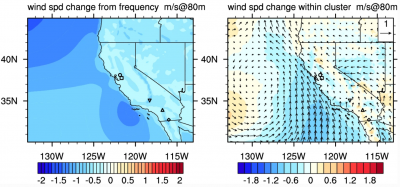Using Cluster Analysis to Understand Future Changes in California's Wind Patterns
By disentangling future change within common wind patterns in California into the changes from frequency and character, new insights emerge into how and why wind fields are changing. Specifically, we explain how seasonal wind patterns are shifting, and how these changes play out in terms of weakening of winter winds and strengthening of summer winds.
Although climate change is known to have a seasonally-dependent impact on the intensity of winds (and consequently wind energy production), most analyses only examine mean wind speed changes. Our novel approach enables us to understand which patterns are expected to become more/less frequent, and how wind patterns are changing.
Wind energy production throughout California is at the mercy of wind speeds that are shifting in response to climate change. Simulating low-level winds requires high model resolution, which often limits our ability to conduct studies addressing the climatology of wind over large regions. This study uses historical and future simulations at 14km resolution using the variable-resolution Community Earth System Model to build a wind climatology for California. Cluster analysis is used to identify common wind patterns in Northern and Southern California. Future change is then decomposed into the changing frequency and character of these wind patterns. This novel strategy allows us to understand which patterns are becoming more/less frequent, and how these shifts subsequently impact wind energy production at wind farms across California. We observe that in Northern California westerly winds are becoming less frequent and weaker, that offshore blocking exhibits decreasing frequency, and that marine air penetration (MAP) will be more frequent and intense. In Southern California, strong alongshore winds and Santa Ana winds are projected to decrease in frequency, accompanied by an increase in weak onshore flow. Overall, wintertime patterns are projected to weaken and summertime patterns are projected to intensify.

